Across the board, I think it’s safe to say museums and other cultural institutions are working towards rectifying their troubling pasts and working towards a more inclusive future. Some museums are doing better than others in regards to seeing this goal into fruition. My visit to MoMA PS1’s Art Book Fair last weekend was a shining example of how museums can correctly and creatively invite underrepresented groups into their space to tell their stories. Two groups at the show,We the News and Manufactoriel, really stood out to me as both engaged with issues of identity and place- the first through zines and social activism, and the latter through reimagining spaces through photography.
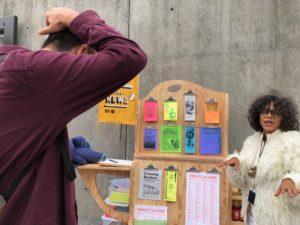
Lizania Cruz was the first artist I spoke to at the fair. I was drawn to the large prints that read “Go Home Yankees” in bright pink across a stark white background. Lizania’s booth was filled with provocative signage calling out white supremacy and colonialism in history as well as its lasting effects on the community here in Brooklyn. She said she’s very interested in exploring the Black Diaspora, the worldwide community of descendants from Africa. I picked up a zine titled “Navigating Nuances of Diasporic Blackness: Tensions within the Black Community” or “Navegando por los matices de la negritud diásporica tensiones dentro de la communidad negra”. Almost all of her publications are available in English and Spanish, which speaks to the intentional intercultural inclusivity within the black community. It’s also worth noting that these zines are typically free and distributed around the Bed-Stuy neighborhood by the We the News collective. In fact zines are a very important form of publications in the field of social activism. Scholar Anna Polleti articulates why the zine tradition is a critical example of disrupting what she describes as mainstream methods of story telling:

“Through the production of independent publications, zine culture seeks to erode the predominance of mainstream and commercial interests in particular cultural activities. The zine community is a form of alternative media, a subculture of story telling and knowledge sharing…” (Polleti 184).
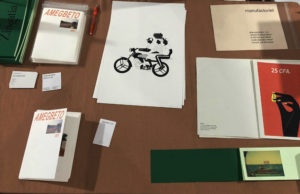
Manufactoriel is a “research proposition in African and Black Contemeporary visual culture, art, and style” (Manufactoriel 2018). I was able to speak with Salwat, an artist in the collective about the work on their table. Each art book responded to themes like the consequences of colonialism and identity politics. One book “Amegbeto”, which means “the one who refused” in Tongan, documents a bi-racial artist’s experience meeting her Tongan family for the first time. My favorite book on the table was created by Salwat herself. She is conducting academic research on a museum in Zanzibar that houses a collection important to Swahili maritime culture, yet the museum is in ruins as a result of decolonization. The museum has no funding and the records and objects left behind are falling apart and forgotten. After she received her master’s degree, Salwat created a book artists book to document the museum’s state of disrepair including some images of the galleries but many blank pages to symbolize the absence or lack of information and care given to the collections.
All in all, the Art Book Fair was not just a space for artists and independent publishers to present their work; it is also a space for underrepresented community’s to share their narratives in a public platform. This is especially important when thinking about the lack of representation topics like the black diasporic experience, or the consequences of colonialism have in major institutions. In a book of essays titled “As radical, as mother, as salad, as shelter: What should art institutions do now” edited by Paper Monument, seeks to address the looming question of how we rectify museums as problematic institutions in the current political environment. The book is formatted in a series of questions and author responses, my favorite question is “Can an art institution go from being an object of critique to a site for organizing? How?” The answers vary. Some think museums should “decentralize the art object and emphasize the process” (Basha 6) others are less optimistic that this change will occur describing efforts made by major institutions as “lip service”. Although I am often wary of museums efforts to be more inclusive, I think MoMA PS1 is doing a great job. Hosting this type of event, outside of the gallery space, creates a different type of information environment that gives vendors like Lizania and Salwat to tell their stories. Not to say that museums are obsolete, or that curated collections are unimportant, but I only mean to suggest that in exploring alternative forms of art consumption through art books, zines, and free events, MoMA PS1 had the opportunity to engage with a larger community. Currently museums are in what feels like the beginning stages of recognizing and rectifying difficult realizations about the foundations and funding surrounding institutions, the next steps to making change are more difficult to identify. But perhaps in thinking outside of the typical pedagogical playbook of what museums have been and should be, we can create spaces that are more creative, thoughtful, and inclusive.
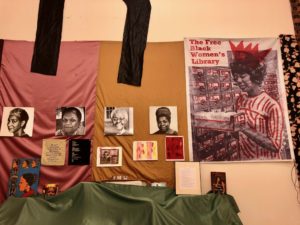
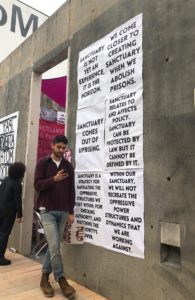
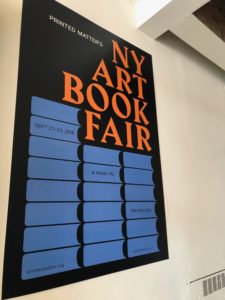 References
References
About. (n.d.). Retrieved September 26, 2018, frmo https://www.manufactoriel.com/about-manufactoriel
Basha, R. (2018) As radical, as mother, as salad, as shelter: What should art institutions do now? Brooklyn, NY: Paper Monument
Liu, M. (2017, March 22). We The News. Retrieved from
Poletti, A. (2005). Self-Publishing in the Global and Local: Situating Life Writing in Zines. Biography,28(1), 183-192. doi:10.1353/bio.2005.0035